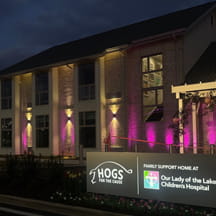Le Bonheur Children’s Hospital and St. Jude Children’s Research Hospital are just one mile apart in Memphis, Tennessee. When St. Jude started a brain tumor program in 1985, the two hospitals began a partnership that would span decades. Today, the Pediatric Brain Tumor Program is one of the largest pediatric surgical brain tumor programs in the country. Frederick Boop, M.D., clearly recalls the foundation on which the program started.
“The agreement between the two hospitals was we would see any child the doctors wanted to bring here for care—and as long as we could, we would keep it going,” says Boop, co-director of the Neuroscience Institute and medical director of the Neurosurgical ICU at Le Bonheur Children’s Hospital; professor and chairman, Department of Neurosurgery at The University of Tennessee Health Science Center, and chief of the division of pediatric neurosurgery at St. Jude Children’s Research Hospital. “And it grew from there.”’
This program is an early example of children’s hospitals partnering on clinical service lines to provide timely access to pediatric specialists and the highest-quality care for patients, avoiding costly duplication of resources and unnecessary competition. And as the health care industry continues to transform, more children’s hospitals are looking to clinical collaborations like this to improve access to services and deliver the kind of health care patients need—when and where they need it.
3 tips for mapping out a partnership
FIND AGREEMENT
“Start with finding your uncompromisable point of agreement because forces that are not always predictable will continually challenge it. If you have a weak unifying point, the partnership will fold. Identify a clear, definable, singular True North that each party believes they can stand behind.”
—MARK SCHEURER, M.D., M.S.c., FACC
Medical University of South Carolina
DEFINE GOALS
“The success of partnerships starts with the CEO and requires a high degree of trust, with partners having a clear understanding of the goals of the collaboration. A strong and successful collaboration must provide mutually beneficial outcomes where the partnership strengthens the organizations.”
—DEBORAH FELDMAN
Dayton Children’s Hospital
MEET IN THE MIDDLE
“The most difficult hurdle we had to cross was the cultural divide between two strong institutions with differing missions. I suspect this will be true of other hospitals attempting to partner—understanding each other’s culture is critical to moving forward together.”
—JON MCCULLERS, M.D.
Le Bonheur Children’s Hospital
Connect across town
When the St. Jude brain tumor program started, it was small and mostly made up of oncologists, Boop says. But over the years, the partnership has grown, and so has its affect. For years, Le Bonheur has managed the surgical aspect of care for St. Jude patients, and after recovering from surgery, the patients return to St. Jude for chemotherapy, radiation therapy and other treatments. When Boop joined Le Bonheur in 1999, the team performed 71 brain tumor surgeries. Last year, the team performed more than 200.
To better leverage each hospital’s services, the two organizations constructed a specialized facility at Le Bonheur where children with brain tumors have surgery. An interoperative MRI unit enables the team to scan and see where the patient’s tumor is and then perform the surgery all in the same location.
“We can do an MRI scan of the patient’s brain while they’re asleep on the table,” Boop says. “That way, number one, we know the brain looks OK at the end. And number two, if we left a piece of tumor behind that we didn’t recognize, we can see it and get it all at the same time—rather than bringing the patient back to surgery again.”
Le Bonheur is also one of only a few children’s hospitals with a neurosurgical intensive care unit, staffed with nurses who are trained in post-brain surgery recovery. “This has improved the quality of care the kids receive and the level of parent satisfaction and comfort,” Boop says.
Adding to their comfort: a united front of St. Jude and Le Bonheur medical professionals. Every week, the team has clinics at St. Jude where neurosurgeons and oncologists meet with patient families to talk about the care plan.
“Families meet us as a team and they recognize us as a team,” Boop says. “And even though they have a St. Jude oncologist assigned to them as their St. Jude doctor, when they’re talking to the surgeons, we talk with them together.” He says that’s been helpful because families are not hearing different things from different people.
“Leveraging the resources and competencies of two major children’s hospitals has resulted in an unmatched team effort in the care continuum,” says Jon McCullers, M.D., pediatrician-in-chief at Le Bonheur Children’s Hospital; senior executive, associate dean of clinical affairs and chief operating officer at The University of Tennessee Health Science Center College of Medicine.
“In the modern era of increasing specialization and innovation, no single institution can offer every service with the level of investment needed to drive the highest quality of care. Development of regional centers of excellence for uncommon or complex conditions allows for cross-referral and fosters collaborative programs that improve care across the board for children.”
Partner city to city
Two children’s hospitals in Ohio—Dayton Children’s Hospital and Nationwide Children’s Hospital in Columbus—are expanding access to care and improving the overall experience for pediatric patients through a partnership of their own.
According to Dayton Children’s President and CEO Deborah Feldman, the path to this partnership was paved in 2013. That’s when a team created Destination 2020, the hospital’s strategic roadmap, which reinforced Dayton Children’s commitment to remain an independent children’s hospital focused on the health of the region’s kids.
A key pillar of this plan is the formation of care alliances. “We recognized partnerships would be critical in the face of significant competitive, human and financial resource challenges,” says Feldman. “These care alliances include adult hospitals, our medical school, the large Air Force base located in Dayton and Nationwide Children’s.”
The team at Dayton Children’s identified clinical needs that could be better met through partnerships, due to either physician recruitment challenges or the lack of enough demand to provide the highest level of care. Specifically, one focus has been on urology, where the two hospitals have developed “a one-program, two-campus approach” to give children across the region “access to the highest-quality pediatric care as close to home as possible,” Feldman says.
For example, it had become difficult for Dayton Children’s to maintain reasonable access to its urology service. Time to third next available appointment was running high. Compounding the issue, a private physician staffed the urology service, and recruitment had been extremely difficult.
Dayton Children’s looked to Nationwide for help and together, they built a urology program that benefited both hospitals and their patients. The teams are achieving results through a provider services agreement in which Nationwide is delivering urology services with two physicians dedicated to Dayton Children’s.
Reach across the state
The Children’s Heart Program of South Carolina is a network of pediatric cardiology providers and outreach centers throughout the state, offering comprehensive inpatient and outpatient cardiovascular care to children in South Carolina and surrounding regions. The program’s origins date back more than 25 years, when relationships among the state’s pediatric cardiologists led to close cardiac care collaboration.
Today, the Children’s Heart Program enables children with cardiac conditions to get high-quality care close to home with their own pediatric cardiology teams, from Greenville to Columbia to Florence. This is valuable to families who don’t have the ability to travel a distance for care, while also making sure the care is economically viable to provide. But the program also affords patients access to a children’s hospital for heart surgeries and procedures when that is the best path to care and cure.
Approximately 90% of children in South Carolina who need heart surgeries have them performed at the Medical University of South Carolina (MUSC) Children’s Hospital in Charleston because the team around the state carefully orchestrates the care plans with the MUSC team. Once the surgeries are performed at MUSC, patients return to their care team at home.
“It’s deference to expertise—it’s not deference to a center,” says Mark Scheurer, M.D., M.S.c., FACC, chief of Children’s & Women’s Services at MUSC and a pediatric cardiac intensivist. “It’s about who knows the family best and who knows the situation best. And our communication lines are strong enough to give families the confidence they will have the support of a team member, no matter where they are or what the issue is.”
Those communication lines are always open among approximately 15 pediatric cardiologists throughout South Carolina and the team at MUSC. The team members around the state are always welcome to join conferences at MUSC, but much of the collaboration is ongoing—everyone has each other’s mobile phone number to ensure timely counsel and decision-making.
And this statewide trusted circle of care is a virtual model that works because the whole team created a culture based on transparent discussion, respectful disagreement and collaborative decision-making. “I know these are soft things, but they are very real,” says Scheurer. “It gets to trust. It allows people to feel comfortable taking risks and speaking out when they feel the risks are unacceptable.”
Engagement and alignment
Feldman shares one key lesson her team learned early in the partnership process: the importance of engaging and aligning physicians at both hospitals in the value of the partnership. “While there was clear visibility of that with senior leaders at the organizations, we found as we began to implement the aspects of this care alliance we had not perfectly aligned physicians,” says Feldman. “Additionally, it’s important to have the opportunity to come together every two to three years to evaluate what’s working and what requires improvement and to identify plans for the future.”
Through a legal joint venture, the partnership between Dayton Children’s and Nationwide also improves access to specialty care while reducing duplication of services in two outlying communities both hospitals serve. And in one community, the two hospitals jointly own and manage a pediatric practice. “More collaborations like this will be necessary in the ever-evolving health care industry,” Feldman says.
Scheurer, no stranger to partnerships, agrees. He conducted his fellowship at MUSC in the early 2000s and returned in 2010 because of the institution’s dedication to teamwork, to partnership and to its mission.
“The mission is to deliver the highest-level outcomes for all these kids in South Carolina, and the only way to do that is collaboratively,” says Scheurer. “Simply having a surgical program without equal emphasis on the primarily ambulatory and sometimes inpatient-based regional parts of our team wouldn’t work. It has to be an equal emphasis. And we’ve adapted to that over time.”
Tackling challenges in the face of change
This approach to care has not come without its challenges, especially in these times of constant change in the health care industry, according to Scheurer. “Our parent organizations are going through dramatic changes—they are consolidating, they are expanding, they are acquiring,” he says. “But there is an outcome and economic viability to this approach when we stay true to the mission because the kids are served well, and so are the participating organizations.”
Scheurer adds it would be tough to make an argument against this virtual model when it’s clearly providing mission-based care that all the parent organizations have as part of their vision and mission.
“The reason the program exists is because it’s extraordinarily mission-based, and it exists because of its teamwork and its outcomes,” says Scheurer. “The unity around that mission—that is the glue that has kept this going.”


